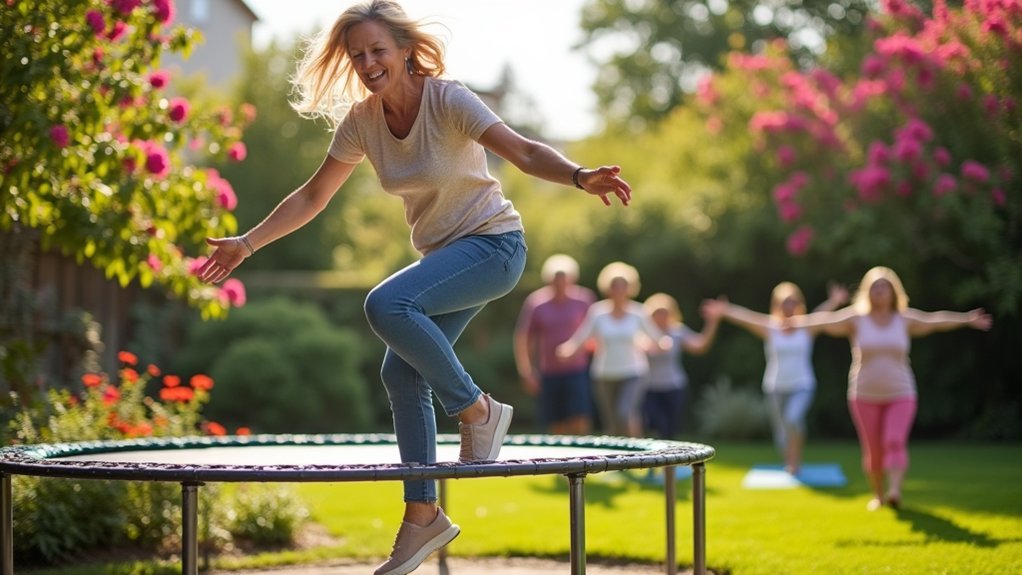Trampoline exercise prevents senior falls by improving your balance recovery abilities by up to 35%. You’ll strengthen critical plantarflexor muscles, engage your core more effectively, and enhance proprioception—your body’s awareness of position. The unstable surface forces 47% greater muscle engagement than firm surfaces, translating to better stability when maneuvering uneven sidewalks or exiting bathtubs. Discover how these specialized movements can dramatically reduce your fall risk through simple, progressive routines.
How Trampoline Exercise Strengthens Fall Prevention Muscles

While many seniors worry about falling, trampoline exercise offers a powerful solution by targeting the specific muscles needed for stability and recovery. When you bounce on a mini-trampoline, you’re strengthening your plantarflexors by about 10%, which are essential muscles for balance recovery.
Your core, glutes, and leg muscles all engage simultaneously during trampoline exercises. Simple movements like squats, heel raises, and leg abductions performed on the unstable surface challenge these muscle groups more effectively than floor exercises.
These targeted exercises strengthen your calf muscles and improve your ability to recover from potential falls by approximately 35%.
The progressive nature of trampoline training allows you to safely increase intensity as your muscles adapt, creating sustained improvements in the specific strength needed for fall prevention. Rebounding significantly enhances balance and coordination in seniors, which are crucial components for preventing falls in daily activities.
The Science Behind Balance Recovery on Unstable Surfaces
When you step onto a trampoline, your body immediately initiates a complex scientific process that enhances balance recovery capabilities. Your brain rapidly reweights sensory inputs, adapting to the unstable environment by increasing proprioceptive feedback.
Research shows unstable surfaces engage your stabilizing muscles 47% more than stable surfaces. This neurological adaptation improves your dynamic stability and ability to respond to perturbations—crucial skills for preventing falls.
When your body faces instability, it activates hidden strength—engaging stabilizer muscles that build better balance and prevent dangerous falls.
While force output decreases by about 29% on unstable surfaces, the increased muscle engagement strengthens your neuromuscular coordination. This training promotes agonist-antagonist co-contractions for better joint protection during daily activities.
This science explains why trampoline exercise is particularly effective for seniors: it creates controlled instability that trains your body’s balance recovery systems. The micro-adjustments you make while balancing translate directly to improved stability in everyday movements, reducing fall risk considerably.
Real-World Benefits: Translating Trampoline Skills to Daily Activities

The scientific principles of trampoline exercise directly translate into practical improvements in everyday life for seniors.
You’ll notice enhanced stability when traversing uneven sidewalks or stepping out of the bathtub—activities where falls commonly occur. The 35% improvement in balance recovery speed means you’ll react faster when encountering unexpected obstacles.
Your strengthened core muscles make lifting groceries and household chores less taxing, while improved proprioception helps you maneuver slippery or uneven surfaces with greater confidence. A regular routine of gentle rebounding exercises can be gradually increased from 5 minutes to 20 minutes per day for optimal results.
You’ll also enjoy better cardiovascular health, giving you more energy throughout the day.
Beyond physical benefits, the endorphin release from rebounding reduces chronic pain and elevates your mood.
This combination of improved balance, strength, and confidence directly supports your continued independence and quality of life.
Comparing Trampoline Training With Traditional Balance Exercises
Both trampoline training and traditional balance exercises offer considerable benefits for seniors, yet they differ in fundamental ways that may influence your choice.
Trampolines provide low-impact, joint-friendly workouts while greatly improving your ability to recover balance after falls. You’ll often find trampolines more engaging, potentially increasing your adherence to regular exercise. Studies show that mini-trampoline exercises significantly improve postural balance in elderly women after just 12 weeks of consistent training.
Traditional exercises like yoga, stability ball work, and aquatic gymnastics offer accessibility advantages—many require minimal equipment and can be done independently at home. They effectively strengthen core and lower-body muscles while enhancing overall flexibility.
When choosing between them, consider your preferences: trampolines typically offer more dynamic movement in supervised settings with safety features, while traditional exercises provide more solo practice options and diverse intensity levels to match your specific needs.
Starting Safe: A Progressive Approach to Senior Trampoline Exercise

Safety serves as the foundation for any successful senior trampoline program, requiring a methodical approach that builds confidence while minimizing risks.
Begin with simple heel raises on your mini-trampoline to strengthen essential calf muscles and enhance ankle stability. You’ll want to use handrails initially if balance is a concern.
Starting with heel raises builds vital calf strength and ankle stability—grab those handrails until your balance improves.
As you progress, incorporate gentle bouncing exercises that engage your core, improving overall stability. Always listen to your body, taking breaks when needed and gradually increasing both duration and intensity. The exercises should follow a steady rhythmic beat to help maintain proper timing and coordination throughout your workout.
Before starting, consult your healthcare provider, especially if you have existing health conditions.
Remember to warm up properly before each session and cool down afterward.
Combining your trampoline routine with other balance activities creates a thorough approach to fall prevention while keeping exercises fresh and engaging.
Frequently Asked Questions
How Often Should Seniors Practice Trampoline Exercises for Optimal Results?
You’ll achieve ideal results by practicing trampoline exercises 3-4 times weekly for 20 minutes daily. Start with shorter 10-minute sessions, gradually building to 45-60 minute workouts twice weekly as your endurance improves.
Can Seniors With Joint Replacements Safely Use Mini-Trampolines?
Yes, you can safely use mini-trampolines with joint replacements if you follow key precautions: get doctor approval, choose models with stability bars, start with gentle bounces, and guarantee proper weight capacity for your needs.
What Specific Footwear Is Recommended for Trampoline Exercises?
For trampoline exercises, you’ll benefit from wearing tennis shoes with good grip, grippy socks, or going barefoot. Choose what feels most comfortable while ensuring you have slip resistance and proper stability for your workout.
Do Medication Side Effects Impact Safety During Trampoline Training?
Yes, medication side effects can greatly impact your trampoline safety. You’ll face increased risks from medications causing dizziness, reduced balance, delayed reactions, or muscle weakness. Always consult your doctor before starting trampoline exercises.
How Long Do Balance Improvements Last Without Continued Practice?
Balance improvements typically last 3-4 months without continued practice. You’ll retain muscle memory and neuromuscular adaptations longer than raw strength gains. Regular maintenance sessions, even brief ones, will greatly extend these benefits.
In Summary
You’ve discovered a powerful tool in fall prevention with trampoline exercise. It strengthens critical muscles, improves your reflexes, and builds confidence on unstable surfaces. By starting gradually with supervised sessions, you’ll develop skills that transfer directly to everyday movements. Unlike traditional balance exercises, trampoline training actively engages your body’s natural stabilizing mechanisms. Make this enjoyable activity part of your routine, and you’ll stand stronger against falls.





Leave a Reply